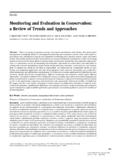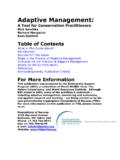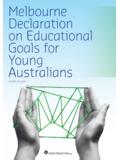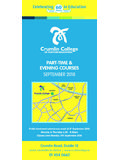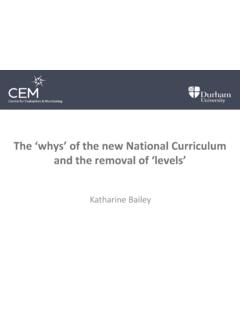Transcription of Using Results Chains to Improve Strategy …
1 Using Results Chains to Improve Strategy effectiveness An FOS How-To Guide May 2007 Foundations of Success Improving the Practice of Conservation Contents What are Results Chains ?..1 Why Results Chains Are Useful .. 1 1. Discuss and Refine Their Theories of Change .. 1 2. Measure 4 3. Develop a Common Framework for Cross-Site 4 When to Use Results Chains .. 5 How to Develop and Use Results Chains .. 5 Step 1. Construct an Initial Results chain Based on Your Conceptual Model .. 6 Step 2. Complete the Links in the Results chain .. 7 Step 3. Verify that Your Results chain Meets Criteria of a Good Results 7 Step 4. Develop Key Results Into Good 8 Step 5. Establish Indicators to Monitor the effectiveness of Your 9 Step 6.
2 Document Your Work .. 10 Examples of Results 10 Example 1. Strategies to Reduce Agricultural Expansion in Grasslands .. 10 Example 2. Strategy to Strengthen Law Enforcement to Reduce Illegal Fishing .. 11 How Project Teams Have Used Results 12 1. Results Chains Help Teams Discuss and Refine their Theories of Change .. 12 2. Results Chains Help Teams Measure effectiveness .. 14 3. Results Chains Help Teams Develop a Framework for Cross-Site Learning .. 14 Some References .. 15 This guide is part of an ongoing series from Foundations of Success. Our aim is to help conservation practitioners design, manage, monitor, and learn from their work. This guide is based on the Adaptive Management principles and practices in the Conservation Measure Partnership s Open Standards for the Practice of Conservation.
3 Materials in this guide have been adapted from previous works produced by Foundations of Success and members of the Conservation Measures Partnership. To provide feedback or comments, you can contact Foundations of Success at Visit our website at to download the most recent version of this guide. Please cite this work as: Foundations of Success. 2007. Using Results Chains to Improve Strategy effectiveness . An FOS How-To Guide. Foundations of Success, Bethesda, Maryland, USA. This work is licensed under the Creative Commons Attribution-Noncommercial-Share Alike License. To view a copy of this license, visit or send a letter to Creative Commons, 171 Second Street, Suite 300, San Francisco, CA 94105, USA.
4 What are Results Chains ? A Results chain is a tool that shows how a project team believes a particular action it takes will lead to some desired result. More specifically, for conservation projects, a Results chain represents a team s assumptions about how project or program strategies will contribute to reducing important threats, leading to the conservation of priority targets. In essence, Results Chains are diagrams that map out a series of causal statements that link short-, medium-, and long-term Results in an fashion. As shown in Figure 1, there are three basic components of a Results chain : a Strategy , expected outcomes, and desired impact. Using these components, a project team can then go on to define objectives and goals that describe desired future outcomes and impacts, respectively (see Box 1 for a definition of these terms).
5 Figure 1. The Basic Components of a Results chain Results Chains are often derived from conceptual models. But they differ in that conceptual models show the state of the world before the project takes action, while a Results chain shows the state of the world resulting from this action. Results Chains are similar to the logic models used by many organizations, but Results Chains have the added benefit of showing more detail and the direct relationship between one result and another. Why Results Chains Are Useful Results Chains help conservation project teams accomplish three things: 1. Discuss and Refine Their Theories of Change Often, project teams implement strategies without really knowing for sure how these actions will lead to conservation.
6 They rely on past experience, expert knowledge, or wishful thinking to guide their selection of strategies. Whatever the reason, they rarely formally state their assumptions about exactly how their strategies will achieve their desired outcomes and impacts. As shown in Figure 2, it is likely that they have many implicit assumptions about how their strategies will contribute to achieving conservation these series of assumptions represent their theory of change. At the same time, it is not uncommon for members from the same team to hold different assumptions that they have not communicated with one another. Because the assumptions are not explicit, the project team cannot come to an agreement on their theory of change or test it and learn over time whether it is valid.
7 Figure 2. Implicit Assumptions 2 Foundations of Success For example, a team may decide that they will help build community capacity for forest resource management and that this will decrease illegal logging in indigenous communities and conserve the state of primary forest in those communities. But, how will they know if that has happened? They may assume that stronger community capacity will increase community knowledge about their rights, and with these rights, they will exert more control over external actors, including those responsible for the illegal logging. The team may also assume this control will result in more illegal wood confiscated and less illegal logging. It is quite likely, however, that they have not made their assumptions explicit and that they are not testing them.
8 As such, they have little chance of systematically testing whether their actions are contributing to less illegal logging and the conservation of primary forest. If, however, the team members make their assumptions explicit Using a Results chain as shown in Figure 3, then they can debate their theory of change both internally and with external stakeholders and advisors. They can see if the Results they expected to see actually materialize. They can also look outside of their Results chain to see if other external factors might be influencing the degree to which they are achieving their expected Results . For Box 1. An Overview of Terms Used to Describe Results There is a great deal of confusion over the different terms used to describe the Results of a project.
9 What one person calls an outcome, another calls a result, and yet a third person calls an impact. The following figure shows the terms as they are most commonly used by evaluation experts in different fields such as development and public health. Based on the above figure, the following terms can be defined for use in Results Chains in biodiversity conservation projects: Strategies The actions or interventions that a project implements. Outcome The desired future state of a threat or opportunity factor. An objective is a formal statement of the desired outcome. Impact The desired future state of a conservation target. A goal is a formal statement of the desired impact. Result A generic term used to describe the desired future state of a target or factor.
10 Includes impacts, outcomes, and outputs. The above terms refer primarily to a sequence of Results in a logical sense. There is also a sequence of Results in a temporal sense: Final result The ultimate desired result over time. Intermediate result A milestone along the way to that final result. Using Results Chains 3 instance, in the community capacity building example, there are many points at which this project team s logic could break down for example, just because the community has greater knowledge about its rights does not mean that they will take the next step and exert more control over illegal loggers. Perhaps there are security concerns that would prevent them from taking action. Or maybe they are able to reduce the amount of illegal selective logging that happens, but the government has just designated a block of forest for clear cutting.
